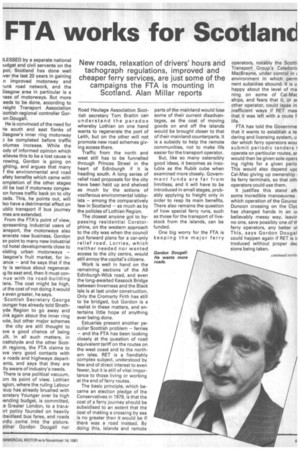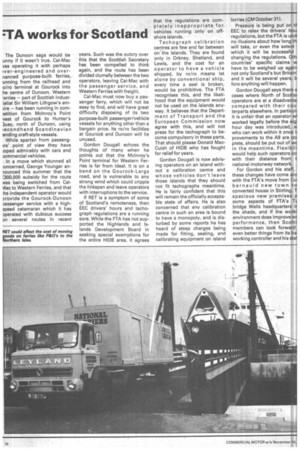FTA works for Scotland
Page 43

Page 44

If you've noticed an error in this article please click here to report it so we can fix it.
New roads, relaxation of drivers' hours and tachograph regulations, improved and cheaper ferry services, are just some of the campaigns the FTA is mounting in Scotland. Alan Millar reports
ILESSED by a separate national ludget and civil servants on the pot, Scotland has done well rver the last 20 years in gaining n improved motorway and -unk road network, and the ilasgow area in particular is a lass of motorways. But more eeds to be done, according to reight Transport Association tottish regional controller Goron Dougall.
He is convinced of the need for le south and east flanks of Pasgow's inner ring motorway 3 be completed before traffic olumes increase. While the ody of informed opinion which elieves this to be a lost cause is rowing, Gordon is going on ghting, and argues that many f the environmental and road afety benefits which came with ompletion of the other stages till be lost if motorway congeson forces traffic back on to city )ads. This, he points out, will !so have a detrimental effect on ublic transport if bus journey mes are extended.
From the FTA's point of view, ?presenting industrial users of ansport, the motorways also enerate new business. Gordon 3n point to many new industrial nd hotel developments close to Kisting urban motorways — lasgow's fruit market, for in:ance — and he says that if the ty is serious about regeneratig its east end, then it must connue with its road-building lens. The cost might be high, Jt the cost of not doing it would a even greater, he says.
Scottish Secretary George ounger has already told Strathyde Region to go away and link again about the inner ring rute, but other major schemes the city are still thought to we a good chance of being jilt. In all such matters, in trathclyde and the other Scot
regions, the FTA claims to we very good contacts with e roads and highways departents, and says that they are Ily aware of industry's needs. There is one political vacuum, Dm its point of view. Lothian 3gion, where the ruling Labour :oup has already brushed with ?cretary Younger over its high lending budget, is committed, :e Greater London, to a trans)r-t policy founded on heavily ibsidised bus fares, and roads rdly come into the picture. either Gordon Dougall nor
Road Haulage Association Scottish secretary Tom Brattin can understand the paradox whereby Lothian on one hand wants to regenerate the port of Leith, but on the other will not promote new road schemes giving access there.
Traffic from the north and west still has to be funnelled through Princes Street in the heart of Edinburgh if it is heading south, A long series of relief road proposals for the city have been held up and shelved as much by the actions of vociferous environmental lobbyists — among the comparatively few in Scotland — as much as by the policies of Lothian Region.
The closest anyone got to bypassing residential Corstorphine, on the western approach to the city was when the council put forward plans for a car-only relief road. Lorries, which neither needed nor wanted access to the city centre, would still annoy the capital's citizens.
Work is well in hand on the remaining sections of the A9 Edinburgh-Wick road, and even the long-awaited Kessock Bridge between Inverness and the Black Isle is at last under construction. Only the Cromarty Firth has still to be bridged, but Gordon is a realist in these matters, and entertains little hope of anything ever being done.
Estuaries present another peculiar Scottish problem — ferries — and the FTA has been looking closely at the question of road equivalent tariff on the routes on the west coast and to the northern isles. RET is a fiendishly complex subject, understood by few and of direct interest to even fewer, but it is still of vital importance to those living or working at the end of ferry routes.
The basic principle, which became an election pledge of the Conservatives in 1979, is that the cost of a ferry journey should be subsidised to an extent that the cost of making a crossing by sea is no greater than it would be if there was a road instead. By doing this, islands and remote parts of the mainland would lose some of their current disadvantages, as the cost of moving goods on and off the islands would be brought closer to that of their mainland counterparts. It is a subsidy to help the remote communities, not to make life easier for the transport operator.
But, like so many ostensibly good ideas, it becomes as insoluble as the Rubik cube when examined more closely. Government funds are far from limitless, and it will have to be introduced in small stages, probably applying to freight only in order to reap its main benefits. There also remains the question of how special ferry runs, such as those for the transport of livestock from the islands, can be funded.
One big worry for the FTA is keeping the major ferry operators, notably the Scotth Transport Group's Caledoni MacBrayne, under control in r environment in which perm nent subsidies abound. It is u happy about the level of ma fling on some of Cal-Mac ships, and fears that it, or ar other operator, could lapse in .inefficient ways if RET mea that it was left with a route f life.
ETA has told the Governme that it wants to establish a te dering and licensing system, u der which ferry operators wou submit periodic tenders 1 operate on particular routes, ar would then be given sole opera ing rights for a given perio This would also depend upc Cal-Mac giving up ownership its ferry terminals, so that othi operators could use them.
It justifies this stand aft some incredible manoeuvres which operation of the Gouroc Dunoon crossing on the Clyc has changed hands in an ui believably messy way, leavir no one, save possibly one of tlferry operators, any better 01 This, says Gordon Dougal could happen again if RET is ir troduced without proper dec sions being taken.
The Dunoon saga would be unny if it wasn't true. Cal-Mac vas operating it with perhaps iver-engineered and overnanned purpose-built ferries, unning from the railhead and o/ro terminal at Gourock into he centre of Dunoon. Western :erries — part of Scottish industialist Sir William Lithgow's em'ire — has been running in corn)etition from Mclnroy's Point vest of Gourock to Hunter's luay, north of Dunoon, using econdhand Scandinavian anding craft-style vessels.
While spartan from passengH-s' point of view they have :oped admirably with cars and :ommercial vehicles.
In a move which stunned all :oncerned, George Younger aniounced this summer that the :300,000 subsidy for the route /vas being switched from CalVIac to Western Ferries, and that :he independent operator would 3rovide the Gourock-Dunoon 3assenger service with a high;peed catamaran which it has 3perated with dubious success 3n several routes in recent
years. Such was the outcry over this that the Scottish Secretary has been compelled to think again, and the route has been divided clumsily between the two operators, leaving Cal-Mac with the passenger service, and Western Ferries with freight.
Cal-Mac must now buy a passenger ferry, which will not be easy to find, and will have great difficulty disposing of its two purpose-built passenger/vehicle vessels for anything other than a bargain price. Its ro/ro facilities at Gourock and Dunoon will lie unused.
Gordon Dougall echoes the thoughts of many when he points out that the Mclnroy's Point terminal for Western Ferries is far from ideal. It is on a bend on the Gourock-Largs road, and is vulnerable to any strong wind which could cripple the linkspan and leave operators with interruptions to the service.
If RET is a symptom of some of Scotland's remoteness, then EEC drivers' hours and tachograph regulations are a running sore. While the FTA has not supported the Highlands and Islands Development Board in seeking special exemptions for the entire HIDB area, it agrees that the regulations are completely inappropriate for vehicles running only on offshore islands.
Tachograph calibration centres are few and far between on the islands. They are found only in Orkney, Shetland, and Lewis, and the cost for an operator to have a vehicle shipped, by ro/ro means let alone by conventional ship, every time a seal is broken, would be prohibitive. The FTA recognises this, and the likelihood that the equipment would not be used on the islands anyway. It believes that the Department of Transport and the European Commission now agree with this, and will not press for the tachograph to become compulsory in these parts. That should please Donald MacCuish of HIDB who has fought for relief for years.
Gordon Dougall is now advising operators on an island without a calibration centre and whose vehicles don't leave those islands that they should not fit tachographs meantime. He is fairly confident that this will remain the officially acceptable state of affairs. He is also concerned that any calibration centre in such an area is bound to have a monopoly, and is disturbed by some reports he has heard of steep charges being made for fitting, sealing, and calibrating equipment on island lorries (CMOctober 31).
Pressure is being put on tt EEC to relax the drivers' hou regulations, but the FTA is und no illusions about how long th will take, or even the extent which it will be successful changing the regulations. 0th countries' specific claims w have to be weighed up again not only Scotland's but Britain' and it will be several years, b fore anything will happen.
Gordon Dougall says there a cases where North of Scotia' operators are at a disadvantal compared with their cou terparts elsewhere. In particuli it is unfair that an operator wl worked legally before the eigl hour day was introduced, ai who can work within it once provements to the A9 are coi plete, should be put out of wc in the meantime. Flexibili would help such operators co with their distance from t national motorway network.
For Gordon and his staff, these changes have come alo with the FTA's move from Cu bernauld new town to converted house in Stirling. T spacious new premises p some aspects of FTA's TL bridge Wells headquarters ir the shade, and if the worki environment does improve vv( performance, then Scotti members can look forward even better things from its ha working controller and his stal






















































































